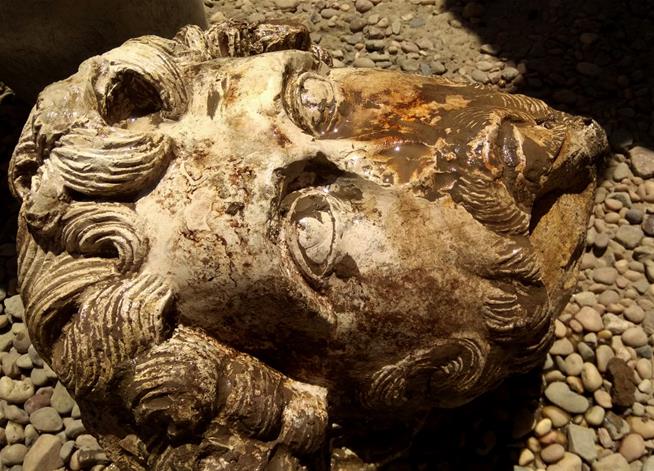
Egypt says archaeologists have discovered a bust of the Roman Emperor Marcus Aurelius in the southern city of Aswan.
The Associated Press is reporting that besides finding the marble head of Roman Emperor Marcus Aurelius, which in itself is a stunning discovery, archaeologists have also unearthed artifacts belongs to a shrine for the god Osiris-Ptah-Neb inside the ancient temple of Karnak in the city of Luxor.
The Aswan mission was working to reduce the subterranean water level at Kom Ombo Temple when the marble bust was found. Aymen Ashmawi, the head of the ancient Egyptian Sector at the Ministry of Antiquities, told Ahram Online that the head depicts Emperor Aurelius with wavy hair and beard. He describes the head as “unique”, saying that statues of the Roman ruler in Egypt are rare.
While operating around Luxor’s Karnak temple, archaeologists discovered on Sunday the architectural remains of the Osiris Ptah Nab Ankh’s compartment.
What was unusual was the shrine’s location. Ashmawy said that the compartment was established inside the Karnak temple in the south of the tenth edifice of the god Amun’s temple, pointing to the importance of the Osirian belief at that time. This is contrary to the other Osiris compartments which were constructed in the temple’s northern and western areas, in accordance with ancient Egyptian beliefs.
This newly discovered compartment reveals the doctrine of Osiris during the 25th dynasty, as well as its connection to the processional road and Mut’s Temple. Excavation revealed the compartment’s entrance, lobby, and internal walls, as well as remains of foundations of a third room located on the eastern side and stone tiles of the compartment floor.
Archaeologists also found a collection of clay pots, remains of statues, and a winged frame relief decorated with offering tables bearing a sheep and a goose. Chief archaeologist, Essam Nagy, said the relief bears the name of kings Taharka and Tanut Amun, the last ruler of the 25th Dynasty.
The Karnak Temple complex at Luxor was developed over more than 1,000 years, principally between the Twelfth and Twentieth Dynasties. At its peak, it was the largest and most important religious complex in ancient Egypt. The biggest and most significant structure is the Temple of Amun-Re, considered to be where that god lived on earth with his wife, Mut, and son, Khonsu. Amun-Re’s wife and son also have temples built in their honor.
Many of Luxor’s temple declined in importance after the dynastic capital was moved to Memphis. And in later centuries, Ptolemaic rulers and Coptic Christians altered parts of the complex for their own uses. But in viewing the Karnak Temple complex, one can see it is massive.
The area was in constant development and use between the Middle Kingdom (2080–1640 B.C.) and the early Christian period. What is particularly interesting is seeing and understanding that the range of architecture in the complex reveals the broad range of religious beliefs and the gods worshipped at Karnak, from some of the earliest Egyptian deities to some of the latest, giving scholars a fascinating history of ancient Egyptian religious practices and beliefs.













